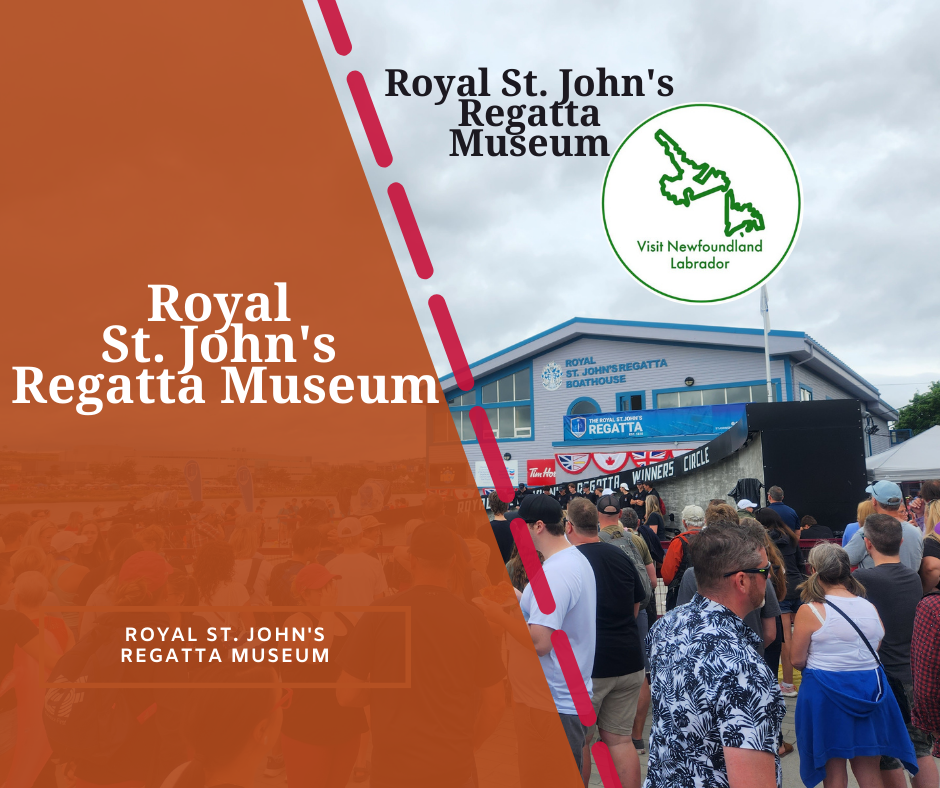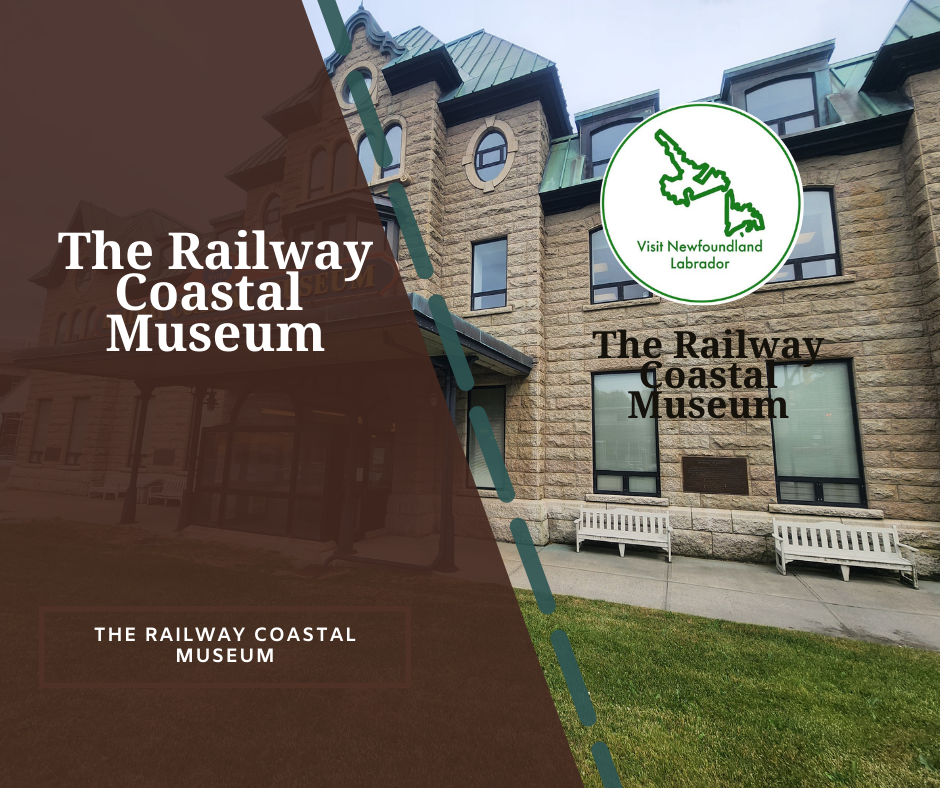The Most Exciting Museums to Explore in St John’s
These are some of the most exciting museums to explore in St John’s. The city of St John’s has many unique places to visit and these are some of the most exciting.
Royal St. John’s Regatta Museum
In the heart of St. John’s, Newfoundland, the Royal St. John’s Regatta Museum is a testament to the region’s rich Atlantic heritage. This museum, dedicated to North America’s oldest organized sporting event, the Royal St. John’s Regatta, offers visitors a captivating journey through history. The Regatta is not just a boat race but a significant cultural event that has shaped the local community for over two centuries.
Upon stepping into the museum, you are greeted with a wide collection of artifacts, photographs, and memorabilia that chronicle the evolution of the Regatta. The exhibits are meticulously curated, showcasing the development of rowing technology, the stories of legendary crews, and the pivotal moments that have defined the event.
The Royal St. John’s Regatta Museum also highlights the social and cultural impact of the Regatta on St. John’s and Newfoundland. The annual Quidi Vidi Lake event brings together the community in a festive celebration, reflecting the spirit of camaraderie and competition. The museum’s exhibits delve into the traditions, such as the iconic food stalls and entertainment accompanying the races, offering a comprehensive view of how the Regatta has become a cornerstone of local identity.

The museum hosts educational programs and workshops, making it a vibrant hub for tourists and locals. These workshops aim to foster a deeper appreciation for the sport of rowing and its historical significance. The Royal St. John’s Regatta Museum is not just a repository of the past. It is a dynamic institution that celebrates and perpetuates the enduring legacy of the Royal St. John’s Regatta.
What is the Royal St. John’s Regatta Museum?
The Royal St. John’s Regatta Museum in St. John’s, Newfoundland, is dedicated to preserving the history and heritage of the Royal St. John’s Regatta, North America’s oldest organized sporting event. It features artifacts, photographs, and interactive exhibits related to the Regatta.
Where is the Royal St. John’s Regatta Museum located?
The Royal St. John’s Regatta Museum is located in St. John’s, Newfoundland, at the edge of Quidi Vidi Lake, the historic site where the annual Regatta races occur. What can visitors expect to see at the Royal St. John’s Regatta Museum? Visitors to the Royal St. John’s Regatta Museum can expect to see different exhibits, including historical rowing boats, photographs, memorabilia, and interactive displays that explore the technical and cultural aspects of the Regatta.
Why is the Royal St. John’s Regatta significant?
The Royal St. John’s Regatta is significant because it is the oldest organized sporting event in North America. It holds immense cultural importance in Newfoundland, bringing the community together for a day of competition and celebration every year. Are there any educational programs at the Royal St. John’s Regatta Museum? Yes, the Royal St. John’s Regatta Museum offers various academic programs and workshops designed to educate visitors about the Regatta’s history, the rowing sport, and cultural significance in Newfoundland.
When is the best time to visit the Royal St. John’s Regatta Museum?
While the Royal St. John’s Regatta Museum is open year-round, the best time to visit is during the annual Regatta event in early August. This allows visitors to experience both the museum and the live excitement of the races. Is the Royal St. John’s Regatta Museum suitable for children?
The Royal St. John’s Regatta Museum is family-friendly and offers interactive exhibits that engage children. Educational programs are also available to make the visit informative and enjoyable for young visitors.
How does the Royal St. John’s Regatta Museum contribute to the community?
The Royal St. John’s Regatta Museum contributes to the community by preserving and promoting the history of the Regatta. It serves as an educational resource and a cultural hub, fostering a sense of pride and continuity in local traditions. Can visitors participate in any Royal St. John’s Regatta Museum activities?
Royal St. John’s Regatta Museum visitors can participate in interactive exhibits and educational workshops. During the annual Regatta event, they can enjoy various festivities and witness rowing demonstrations or races.
Where to Stay
St. John’s, the capital city of Newfoundland and Labrador, Canada, is a vibrant and colourful destination that offers visitors a unique experience. The city has something for everyone, from its stunning beauty to its rich cultural heritage. One of the key elements to planning a successful trip to St. John’s is choosing the right place to stay.
Hotels: For visitors looking for a comfortable and convenient stay in St. John’s, hotels are a popular choice. The city has a wide range of hotel options to suit different budgets and preferences.
The Rooms Museum

The Rooms Museum in St. John’s, Newfoundland, is a cultural epicentre that blends Newfoundland and Labrador’s rich history, vibrant art, and cultural heritage. This striking building, with its distinctive peaked red roofs, is a significant landmark in the St. John’s cityscape.
The museum houses different sections: the Provincial Archives, Art Gallery, and Museum. Each section offers a unique glimpse into the region’s heritage. The Provincial Archives safeguard the documentary history of Newfoundland and Labrador, preserving government records, private papers, photographs, maps, and more. This collection is invaluable for researchers delving into the province’s past.
The Art Gallery, meanwhile, is a premier space dedicated to contemporary art, featuring works from Newfoundland and Labrador artists and pieces from across Canada and the world. The gallery’s permanent collection includes thousands of works focusing on local artists.
The museum division showcases Newfoundland and Labrador’s natural and cultural history through various exhibits. From dioramas depicting the tundra and bog ecosystems to displays of the province’s Indigenous peoples, the museum offers an immersive educational experience. Notably, it features extensive collections related to the Innu, Mi’kmaq, and Inuit peoples, along with archaeological artifacts from the Beothuk and other early cultures.
The Rooms is more than just a museum. It is a cultural hub that celebrates and preserves the diverse heritage of Newfoundland and Labrador.
What is The Rooms Museum in St. John’s, Newfoundland?
The Rooms Museum is a cultural complex in St. John’s, Newfoundland, that displays Newfoundland Archives, Art, and artifacts. It showcases the region’s history, art, and cultural heritage, providing a comprehensive insight into the province’s past and present. What can visitors expect to see at The Rooms Museum? You can explore permanent displays of Newfoundland and Labrador natural history, archaeology, and ethnology. The museum also features art galleries with contemporary and historical works and archives with extensive documentary collections.
Where is The Rooms Museum located?
The Rooms Museum is at 9 Bonaventure Avenue, St. John’s, Newfoundland and Labrador. It occupies a prominent position in the city, offering panoramic views of St. John’s Harbour, The Narrows, and Signal Hill. What type of art is featured in The Rooms Art Gallery? The Rooms Art Gallery showcases diverse art, including contemporary and historical works. How does The Rooms Museum preserve the history of Newfoundland and Labrador? The Rooms Museum preserves the history of Newfoundland and Labrador through its extensive collections in the archives, art gallery, and museum. The archives maintain essential documents and records, while the museum exhibits artifacts and the art gallery displays significant works of art.
Can visitors access archival materials at The Rooms Museum?
Yes, visitors can access various archival materials at The Rooms. The Provincial Archives provide access to government records, private papers, photographs, maps, and other historical documents crucial for research and education. Does The Rooms Museum host temporary exhibitions?
Yes, The Rooms Museum regularly hosts temporary exhibitions that feature various aspects of Newfoundland and Labrador’s history, culture, and art. These rotating exhibits ensure that there is always something new for visitors to explore and learn about.
How to get around the city:
The easiest way to get around St. John’s is by renting a car. There are several car rental companies in the city, and renting a car gives you the freedom to explore at your own pace. You can quickly drive to some of the city’s top attractions, like Signal Hill or Cape Spear Lighthouse, and there’s plenty of parking available. Plus, having a car is essential if you plan to venture outside St. John’s.
Use public transportation.
St. John’s has a reliable public transportation system if you prefer to avoid driving. The Metrobus operates throughout the city and surrounding areas, and there are several routes to choose from. Fares are affordable, and you can purchase a day pass if you plan on using the bus frequently. The Metrobus website has a trip planner tool that makes finding the best route to your destination easy.
Take a taxi
Taxis are readily available in St. John’s. You can stop s taxi on the street or call to book one through a local taxi company. These services are convenient if you need to travel to a specific destination and want to avoid parking.
Jiffy Cabs: 709-722-2222
City Wide Taxi: 709-722-7777
Red & Yellow Cabs: 709-726-6666
Bugdens: 709-722-4400
Newfound Cabs: 709-744-4444
The Railway Coastal Museum

The Railway Coastal Museum offers visitors a fascinating glimpse into the history of Newfoundland railways and coastal boat services. Located in the historic Newfoundland Railway Station, this museum is a testament to the province’s rich transportation heritage.
Firstly, the museum’s exhibits meticulously detail the evolution of the Newfoundland Railway from its inception in the late 19th century to its eventual closure. You can explore different artifacts, including vintage locomotives, model trains, and historical photographs that bring the past to life. Notably, the museum also features interactive displays, which engage everyone, making history accessible and entertaining.
Additionally, the Railway Coastal Museum pays homage to the coastal boat service that was crucial in connecting the island’s remote communities.
Moreover, the museum offers a unique insight into the daily lives of those who worked on the railways and coastal boats. Personal stories, diaries, and letters are on display, offering an intimate perspective on the challenges and triumphs faced by these individuals. This human element enriches the visitor experience, fostering a deeper connection to the province’s history.
The Railway Coastal Museum in St. John’s, Newfoundland, is more than just a place of historical artifacts. It is a vibrant educational resource that celebrates the province’s transportation legacy.
Quirky and Unusual Things to Do in St John’s: 19 Quirky and Unusual Things to Do in St John’s.
What is the Railway Coastal Museum in St. John’s, Newfoundland?
The Railway Coastal Museum in St. John’s, Newfoundland, is dedicated to preserving and showcasing the history of Newfoundland railways and coastal boat services. It is located in the old Newfoundland Railway Station and features many exhibits, artifacts, and interactive displays.
Where is the Railway Coastal Museum located? The Railway Coastal Museum is in the historic Newfoundland Railway Station at 495 Water Street, St. John’s, Newfoundland. This central location makes it easily accessible for visitors exploring the city.
What can visitors expect to see at the Railway Coastal Museum?
Visitors to the Railway Coastal Museum can expect to see a variety of exhibits, including vintage locomotives, model trains, historical photographs, and artifacts related to the Newfoundland Railway and coastal boat services. The museum also features interactive displays and personal stories from individuals who worked on the railways and boats.
Why is the Railway Coastal Museum significant? The Railway Coastal Museum is substantial because it preserves and celebrates the history of Newfoundland transportation networks. The museum highlights the vital role that railways and coastal boats played in connecting the island’s remote communities and supporting its economic development.
Are there any special events or programs at the Railway Coastal Museum?
The Railway Coastal Museum hosts various special events and educational programs annually. These include guided tours, workshops, and family-friendly activities to engage visitors of all ages and deepen their understanding of Newfoundland transportation history. How long does it typically take to tour the Railway Coastal Museum?
A typical tour of the Railway Coastal Museum takes about 1 to 2 hours. These tours give visitors ample time to explore the exhibits, participate in interactive displays, and absorb the wealth of historical information.
Is the Railway Coastal Museum suitable for children?
Absolutely! The Railway Coastal Museum is family-friendly and offers interactive, educational and entertaining exhibits for children. The museum aims to make history accessible and enjoyable for visitors of all ages. What are the opening hours of the Railway Coastal Museum?
The Railway Coastal Museum is open daily, with varying hours depending on the season. The museum operates from June to September.
Is there an admission fee to access the Railway Coastal Museum?
Yes, there is an admission fee. However, the cost is modest and contributes to the preservation and maintenance of the museum. Discounts are often available for children, seniors, and groups—$ 4 to $10.
How can I get more information about the Railway Coastal Museum?
For more information about the Railway Coastal Museum in St. John’s, Newfoundland, you can visit their official website or contact them directly—the website details exhibits, events, admission fees, and opening hours.
Johnson Geo Centre

Located midway up scenic Signal Hill in St. John’s, Newfoundland, the Johnson Geo Centre is a must-visit destination for geology enthusiasts and curious minds. This state-of-the-art science center, carved deep into the solid bedrock of the iconic hill, offers an immersive experience of the geological history of our planet, with a particular focus on Newfoundland and Labrador.
The Geo Centre’s exhibits are fascinating and educational, providing a comprehensive look at the Earth’s billions of years of history. Visitors can explore the main exhibit area, where they will find captivating displays of the geological forces that shaped our planet. The center also highlights the unique geology of Newfoundland, showcasing ancient rock formations and fossils that date back many eras. Additionally, the Johnson Geo Centre features interactive exhibits that engage visitors of all ages. This level of engagement makes it an ideal destination for families and school groups.
One of the Johnson Geo Centre highlights is the ExxonMobil Oil and Gas Gallery, which delves into the science and technology behind oil and gas exploration and production. This exhibit provides an in-depth look at the industry’s impact on the province and the world, blending educational content with cutting-edge technology.
Website: Johnson Geo Centre › Visit Newfoundland and Labrador.
The Johnson Geo Centre in St. John’s, Newfoundland, is a treasure trove of geological knowledge and a testament to the province’s rich natural resources history. Its engaging exhibits, stunning location, and educational programs make it a beacon of learning and exploration for visitors from near and far. Whether a seasoned geologist or a curious traveller, the Johnson Geo Centre promises an enriching experience that will leave you with a deeper appreciation for the Earth geological wonders.
What is the Johnson Geo Centre in St. John’s, Newfoundland?
The Johnson Geo Centre is a geological interpretation center on Signal Hill in St. John’s, Newfoundland. It offers exhibits that explore the geological history of Newfoundland and Labrador and the Earth.
What can visitors expect to see at the Johnson Geo Centre?
Visitors can expect to see interactive exhibits on the Earth’s geological history, ancient rock formations, fossils, oil and gas industry displays.
Where is the Johnson Geo Centre located?
The Johnson Geo Centre is on Signal Hill in St. John’s, Newfoundland, offering stunning views and an immersive geological experience. 175 Signal Hill Road, St. John’s, Newfoundland and Labrador Why is the Johnson Geo Centre significant? The Johnson Geo Centre is significant because it educates visitors about the geological history of Newfoundland and Labrador, showcasing unique rock formations and fossils that provide insights into the Earth’s ancient past.
What is the ExxonMobil Oil and Gas Gallery at the Johnson Geo Centre?
The ExxonMobil Oil and Gas Gallery is an exhibit at the Johnson Geo Centre that explains the science and technology behind oil and gas exploration and production, highlighting its impact on Newfoundland and the world. How does the Johnson Geo Centre engage visitors of all ages?
The Johnson Geo Centre engages visitors of all ages through interactive exhibits, educational programs, and hands-on activities that make learning about geology fun and accessible.
What is unique about the geological displays at the Johnson Geo Centre?
The geological displays at the Johnson Geo Centre are unique because they feature rock formations and fossils from Newfoundland that date back to the many era, providing a rare glimpse into the Earth’s ancient history.
How does the Titanic Story exhibit at the Johnson Geo Centre connect to Newfoundland?
The Titanic Story exhibit at the Johnson Geo Centre connects to Newfoundland by highlighting the province’s role in the Titanic disaster, including the recovery efforts and the ship’s last known coordinates near Newfoundland waters. Can school groups visit the Johnson Geo Centre?
Yes, school groups are welcome at the Johnson Geo Centre. The Geo center offers educational programs and guided tours tailored to different age groups, making it an excellent field trip destination. How does the Johnson Geo Centre contribute to the local community? The Johnson Geo Centre contributes to the local community by promoting education, tourism, and a greater appreciation for the geological history of Newfoundland and Labrador.

Is St. John’s, Newfoundland, worth visiting?
St. John’s, the capital, is worth visiting. St. John’s offers a rich cultural heritage, a vibrant arts scene, and breathtaking natural landscapes. Known for its colourful row houses, historic sites like Signal Hill, and picturesque harbour, St. John’s provides a unique blend of natural beauty. The city’s friendly locals, lively music scene, and excellent seafood add to its charm, making it a must-visit destination.
What is St. John’s, Newfoundland, famous for?
St. John’s is famous for several things:
- Signal Hill: This historic site offers panoramic views, and the Cabot Tower is where the first transatlantic wireless communication was received.
- George Street is renowned for its nightlife, with the most bars and pubs per capita in North America.
- Colourful Row Houses: Known as Jellybean Row, these brightly painted homes are iconic.
- Rich History: As one of the oldest cities in North America, it has a rich maritime history and cultural heritage.
How many days does it take to visit St. John’s, Newfoundland?
To fully experience St. John’s and its surroundings, a visit of 4 to 5 days is recommended. This allows time to explore the city’s historical sites, enjoy the local cuisine, enjoy the nightlife on George Street, and venture out to nearby natural attractions such as Cape Spear and Quidi Vidi Village.
Is St. John’s, Newfoundland, a walkable city?
Yes, St. John’s is a walkable city, especially in the downtown area, where many attractions, restaurants, and shops are concentrated. The city’s hilly terrain can be challenging, but it also offers beautiful vistas and charming streets to explore on foot.
What is the best month to visit Newfoundland?
The best months to visit Newfoundland are from late June to early September. The weather is milder during this period, and you can enjoy outdoor activities like hiking, whale watching, and iceberg spotting. July and August are viral for tourists.
What is the best time of year to visit St. John’s, Newfoundland?
The best time to visit St. John’s is during the summer, from June to early September. During this time, the weather is warm, and many festivals and events occur. This is also the peak season for whale-watching and iceberg viewing.
Is St. John’s Newfoundland expensive?
St. John’s can be moderately expensive, especially during peak tourist season. Accommodation, dining, and activities can add up, but budget-friendly options are also available. Compared to larger Canadian cities, St. John’s is relatively affordable.
Is Newfoundland expensive to visit?
Newfoundland is not excessively expensive to visit, but costs can vary depending on the time of year and type of accommodation. While certain activities and dining experiences may be costly, there are plenty of free or low-cost activities to enjoy.
What is the famous street in St. John’s, Newfoundland?
George Street is famous in St. John’s for its vibrant nightlife and numerous bars and pubs. George Street is a popular spot for locals and tourists looking to experience live music and socialize.
Can you get around St. John’s without a car?
Yes, you can get around St. John’s without a car, especially downtown, where many attractions are within walking distance. You’ll have access to convenient transportation options, such as public transportation, taxis, and ride-sharing services.
How long is the ferry ride from Nova Scotia to St. John’s, Newfoundland?
There is no direct ferry to St. John’s. However, you can take a ferry from North Sydney, Nova Scotia, to either Argentia (a 16-hour ride) or Port aux Basques (a 6–8-hour ride) in Newfoundland. From there, you must drive to St. John’s, which takes approximately 1.5 hours from Argentia or 9 hours from Port aux Basques.
How long does it take to drive around St. John’s?
Driving around St. John’s can take about an hour, depending on traffic and stops. Exploring the greater St. John’s area, including nearby attractions like Cape Spear and Quidi Vidi, can take several hours.
What is the crime rate in St. John’s, Newfoundland?
St. John’s has a relatively low crime rate compared to other Canadian cities. While it experiences typical urban crime, it is generally considered a safe place for residents and visitors.
How cheap is Newfoundland?
Newfoundland is relatively affordable compared to other parts of Canada. While some areas, especially St. John’s, can be expensive, smaller towns and rural areas, however, offer more budget-friendly options for accommodation and dining.
What is the best way to tour Newfoundland?
The best way to tour Newfoundland is by car. This allows you to explore the island’s diverse landscapes, remote villages, and natural attractions at your own pace. Renting a car is recommended if you’re flying into the province.
In what month do you see icebergs in Newfoundland?
Iceberg season in Newfoundland typically runs from late May to early June, though icebergs can sometimes be seen as late as July. The best month for iceberg viewing is usually June.
What is the best month to see icebergs in Newfoundland?
June is generally the best month to see icebergs in Newfoundland. This is when most icebergs drift along the coast, providing spectacular viewing opportunities.
When can I see puffins in Newfoundland?
Puffins can be seen in Newfoundland from late May to early September. The best months to see them are June and July, when they are most active during their breeding season.
What is the wettest month in Newfoundland?
October is typically the wettest month in Newfoundland, and it experiences the highest average rainfall.
When can you see whales in St John’s, Newfoundland?
Whale-watching season in St. John’s is from mid-June to mid-August. During this time, humpback, minke, and other whale species migrate through the waters of Newfoundland.
What should I pack for St. John’s, Newfoundland?
When visiting St. John’s, pack layers to accommodate varying weather conditions. Essentials include:
- Waterproof jacket and footwear
- Warm clothing (sweaters, hats, gloves)
- Comfortable walking shoes
- Sunscreen and sunglasses
- Cameras and binoculars for wildlife and iceberg viewing
Can you see the Northern Lights from Newfoundland?
You can watch the Northern Lights (Aurora Borealis) from Newfoundland, particularly in low-light pollution areas. The best time to see them is from late fall to early spring.
Where is the best place to see whales and icebergs in Newfoundland?
Twillingate and Bonavista are Newfoundland’s best places to see whales and icebergs. These coastal areas offer excellent viewing opportunities and tours.
Are there polar bears in Newfoundland?
Polar bears are occasionally seen in the northern parts of Newfoundland and Labrador, particularly in the Labrador region. They are not commonly found in Newfoundland itself.
How long does it take to drive from one end of Newfoundland to the other?
Driving from the western end of Newfoundland (Port aux Basques) to the eastern end (St. John’s) takes approximately 9–10 hours without significant stops.
Is Fogo Island worth visiting?
Fogo Island is worth visiting for its unique culture, stunning landscapes, and renowned Fogo Island Inn. It offers a distinctive experience of Newfoundland’s heritage and natural beauty.
How often can you see northern lights in Newfoundland?
The Northern Lights can be seen in Newfoundland several times a year, particularly during periods of high solar activity. The best times are during winter when nights are longer and darker.
What is the best time to see the Northern Lights?
The best time to see the Northern Lights is during the winter, from late September to early April, particularly around midnight or early morning.
How long is the ferry ride to Fogo?
The ferry ride to Fogo Island from Farewell, Newfoundland, takes approximately 45 minutes to an hour.
How much is the ferry to Fogo Island?
As of the latest information, the ferry to Fogo Island costs around $15–20 CAD per vehicle and additional fees for passengers, but prices can vary, so it’s best to check current rates.
What is so special about Fogo Island?
Fogo Island is unique for its rugged natural beauty, traditional outport culture, and the acclaimed Fogo Island Inn. It’s known for its artistic community, distinctive architecture, and stunning coastal Scenery.
Are there narwhals in Newfoundland?
Narwhals are typically found in Arctic waters and are uncommon in Newfoundland.
Are there dolphins in Newfoundland?
Yes, dolphins can be seen in the waters around Newfoundland, including species like the Atlantic white-sided dolphin and the common dolphin.
Are there killer whales in Newfoundland?
Killer whales (orcas) are occasionally sighted around Newfoundland, especially during summer.
What is Cape Spear known for?
Cape Spear is known for being the easternmost point in North America. It features a historic lighthouse and offers stunning 180-degree views of the Atlantic Ocean, making it a popular tourist spot.
Where can I see whales in Newfoundland?
Some of the best places to see whales in Newfoundland include:
- St. John’s and Cape Spear
- Trinity and Bonavista
- Twillingate
- Witless Bay Ecological Reserve
How do you see puffins in St John’s?
To see puffins near St. John’s, visit the Witless Bay Ecological Reserve island, which is home to large colonies of puffins. Boat tours from Bay Bulls can take you close to the puffin nesting sites.
How long do you need to see Newfoundland?
Plan to spend at least 7–19 days to see Newfoundland highlights. This allows enough time to explore St. John’s, the Avalon Peninsula, Gros Morne National Park, and other key attractions.
When should I go to Newfoundland?
The best time to visit Newfoundland is from late June to early September when the weather is mild. You can enjoy outdoor activities, events, and festivals. This period is also ideal for whale-watching and iceberg-viewing.
These are the best travel planning resources you should use.
Looking to book your trip to Newfoundland and Labrador? Use these resources that are tried and tested by other travellers like you who vacation in Newfoundland and Labrador. Bookmark these links. Save them for future reference.
Booking Flights, Hotels or B&B: Start planning your next vacation trip by finding the best flight, hotel or b&b deals. Book Here
Finding things to do in Newfoundland and Labrador on TripAdvisor and Viator is not hard. Enjoy boat tours, whale watching, icebergs watching, kayaking and other activities.
You can also find low prices on hotels, B&B and cabins with these two providers. If you are located in Canada, the USA, the UK or Europe, use Booking.com, and if you are in Canada, the USA or anywhere else, use TripAdvisor.
Car Rental: Here is what we recommend:
When you book with Rentalcars.com, you can compare prices and find the best vehicle for your trip. Economybookings.com Display all their vehicle on the website with a detailed description. They display high-quality photos and a user rating as well. Qeeq.com serves road trip travellers like you from different countries by working with car rental companies worldwide.
Get compensated if your flight is delayed or cancel
AirHelp and Compensateair will help you with flight delays, cancellations, or denied boarding. All you need to do is to submit your flight details, and they will handle the claim process on your behalf. They will handle all the paperwork, airline negotiations, and legal proceedings.
Do you need more help planning your trip?
Check out our Resources Page, where we highlight all the resources and companies you can use to assist with your planning.
Where can I find more information about travelling to Newfoundland and Labrador? Here are helpful resources for planning your trip:
Newfoundland and Labrador Tourism | Travel Canada | The Rooms Provincial Museum

